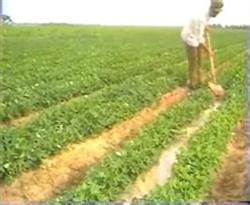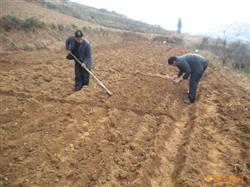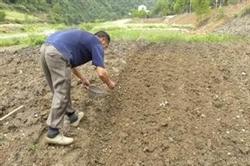Topdressing technology of peanut and soybean

It is an important measure to improve the yield of peanut and soybean under different conditions to do a good job of topdressing in the middle and late stages. 1. Peanuts Peanut topdressing is mainly in the flowering needle stage, when the nitrogen fixation capacity of peanut rhizobia has gradually decreased, and the plant has entered the peak period of nutrient absorption, topdressing can be divided into two situations: 1. Field blocks without phosphorus or compound fertilizer applied in base fertilizer. For this kind of peanut, due to the lack of nutrients in the early stage, the vegetative body is generally weak, and the main purpose is to increase fat and promote growth. Generally, about 10 kg of high-concentration compound fertilizer is dissolved in water per mu and then applied. If the leaf color is pale, 3-5 kg of urea should be added. After fertilization, the soil should be loosened in time to block the roots. 2. Fields that have been treated with phosphate fertilizer or compound fertilizer as base fertilizer. For the general growth, 5-8 kg urea per mu can be applied, and the soil fertility is relatively high. The field with prosperous growth can not be applied. II. Soybean The nitrogen-fixing ability of Rhizobia is related to soil fertility. Under the condition of acceptable soil fertility in our city, the nitrogen-fixing amount of Rhizobia is equivalent to 1/4-1/2 of the nitrogen required, and the biological yield of soybean is higher than that of peanut, and the total absorption of nutrients is correspondingly higher. Topdressing is an important measure for high yield of soybean. 1. Apply flower and pod fertilizer skillfully. After flowering, soybean enters the stage of simultaneous vegetative growth and reproductive growth, and its demand for nutrients reaches its peak. If nutrients are deficient and light is insufficient, a large number of flowers and pods will fall off, and the rate of flower and pod shedding will reach 70-80% in severe cases. The soybean pod fertilizer is generally irrigated with urea 8-10 kg per mu. For the fields without phosphorus and potassium application in the basal fertilizer, 10-12 kg of high-concentration compound fertilizer shall be dissolved in water per mu and then applied. The amount of topdressing can be adjusted according to the growth of soybean. 2. Foliar fertilization. The root activity and fertilizer absorption ability of soybean in late growth stage were weakened, and fertilization was inconvenient, while the fertilizer absorption function of leaves was strong, so foliar spraying fertilizer could be carried out. Soybean with general growth and weak growth can be sprayed with 0.3% urea solution and 0.2% potassium dihydrogen phosphate solution to drip water; soybean with strong growth can be sprayed with 0.2% potassium dihydrogen phosphate solution alone. At the same time, trace element foliar fertilizer can be sprayed on most fields.
- Prev

Good control effect of diseases and insect pests during peanut sowing
Peanut pests and diseases harm many kinds, wide range of occurrence, serious harm. Due to the different occurrence, distribution, epidemic law, harm period and living habit of various diseases and insect pests, it is difficult to prevent and control them in suitable period. Practice shows that when sowing, pest control can save peanuts caused by pests and diseases.
- Next

Make good use of base fertilizer when sowing peanuts and soybeans
Some farmers do not apply any fertilizer when sowing these crops, which is one of the important reasons that restrict the yield of peanuts and soybeans. Although legume crops can use the nitrogen fixation function of rhizobium to absorb nitrogen in the air to supplement nutrients, but the amount of nitrogen fixation is only 2 × 3-1 × 2, and phosphorus and potassium nutrients.
Related
- The first cup of black tea in spring, the flavor and history of tea gardens in Kenya, Africa
- The computer can not only choose potatoes, but also grow tea rice. AI will grow winter oolong tea champion.
- It is not only the inflated tea bitten by insects, but also engraved with the four seasons tea in Beipu.
- The Oriental Beauty Tea Festival in Zhuxian County takes the stage at the weekend to experience the plus-size feast of oil tea.
- & quot; Oriental Beauty Tea & Exploration of Emei in Hsinchu, the hometown of quot;
- The new variety of strawberry "Tainong 1" dessert is the first choice with mellow aroma. Crimson gorgeous
- History of Tea in Taiwan: from Wild Inner Mountain to Export Tea Garden
- Two types of Taiwan Oriental Beauty Black Tea won the British three-Star Award for Childhood Tea Xiang Zhang Jiaqi changed from pilot to champion tea maker.
- Banana species and varieties: the planting history of Taiwan Xianren banana and dwarf banana is long, is banana disease resistant?
- Coffee planting Technology: Qianjie Coffee from Seedling to harvesting

